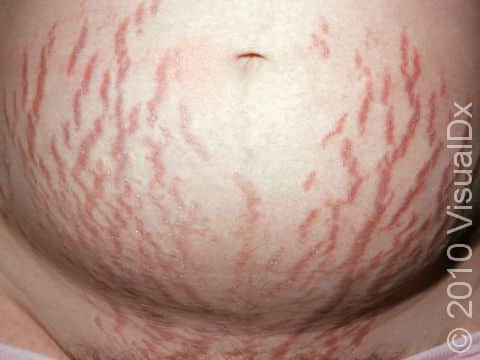Stretch Marks of Pregnancy (Striae of Pregnancy)
Striae gravidarum is the medical term for the stretch marks that occur in most women during pregnancy. As the baby grows, the skin is not able to continue stretching, and the inner layers of skin (the layers of the dermis) rip, causing pinkish lines to appear on the outer layer of skin (the epidermis). These lines eventually fade to light or white lines, but they never go away entirely.
Who's At Risk?
Stretch marks in pregnancy usually occur in the third trimester, when the baby is growing the most, and they occur in up to 90% of pregnant women. They are associated with obesity in the mother, younger mothers, and larger babies. There is no proven treatment for stretch marks; cocoa butter is a common “old wives’ tale” preventative treatment or cure, and while it is not proven to work, it is not known to be harmful and might help.
Signs & Symptoms
Stretch marks look like light pink to red to purple lines that mostly occur on the belly but can appear on the buttocks, breast, thighs, and upper arms.
Self-Care Guidelines
There are numerous products on the market that claim to help prevent stretch marks, but there is no accepted consensus among specialists determining what is effective. Based on a review of the medical literature, there have been two studies that compare different products to placebo (in this case, using a cream that contains no active ingredients). One study found that massage with Trofolastin cream (containing Centella asiatica extract, alpha tocopherol, and collagen-elastin hydrolysates) and verum ointment (containing tocopherol, panthenol, hyaluronic acid, elastin, and menthol) was associated with fewer women developing stretch marks. It is thought that the actual act of massage with any type of cream or ointment is beneficial to prevention of stretch marks, however.
Treatments
Most stretch marks will become smaller postpartum and fade to pale flesh- or silver-colored lines over time. There are some treatments available, but their relative risks and expected benefits should be reviewed with your physician. Topical tretinoin (Retin-A®) or oral tretinoin have been used to treat dark stretch marks. These medications should not be used without using two forms of birth control, as they have been found to cause birth defects, and should not be used by lactating women. Dermabrasion has also been used by some. The pulsed dye laser (585nm) has also been found to be helpful in lightening stretch marks, but different people will have different responses.
Visit Urgency
No therapy is necessary, as they will usually fade after delivery (postpartum).
References
Bolognia, Jean L., ed. Dermatology, pp. 431, 1542-1543. New York: Mosby, 2003.
Wolff, Klaus, ed. Fitzpatrick’s Dermatology in General Medicine. 7th ed, pp. 559, 955. New York: McGraw-Hill, 2008.
Last modified on August 16th, 2022 at 2:44 pm

Not sure what to look for?
Try our new Rash and Skin Condition Finder
